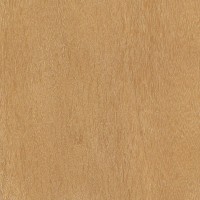|
 |
Common Name(s): Tatajuba Scientific Name: Bagassa guianensis Distribution: Northeastern South America Tree Size: 65-100 ft (20-30 m) tall, 2-3 ft (.6-1 m) trunk diameter Average Dried Weight: 50 lbs/ft3 (800 kg/m3) Specific Gravity (Basic, 12% MC): .68, .80 Janka Hardness: 1,720 lbf (7,650 N) Modulus of Rupture: 17,930 lbf/in2 (123.7 MPa) Elastic Modulus: 2,752,000 lbf/in2 (18.98 GPa) Crushing Strength: 11,440 lbf/in2 (78.9 MPa) Shrinkage: Radial: 4.4%, Tangential: 5.9%, Volumetric: 9.6%, T/R Ratio: 1.3 |
Color/Appearance: Color of freshly sawn heartwood ranges from bright yellow to golden yellow, darkening to a golden or reddish brown upon exposure to light. Pale yellow-white sapwood is sharply demarcated from heartwood. Quartersawn surfaces have a striped figure similar to Sapele’s ribbon stripe, though the stripes are much broader.
Grain/Texture: Interlocked grain, with a medium, uniform texture. Has a good amount of natural luster.
Endgrain: Diffuse-porous; large to very large pores in no specific arrangement, very few; solitary and radial multiples of 2-3; tyloses common; narrow to medium rays barely visible without lens, spacing wide to normal; parenchyma vasicentric and lozenge.
Rot Resistance: Tatajuba has been reported to be durable to very durable regarding decay resistance, with good resistance to insect attack. However, it’s reported to have rather poor weathering characteristics.
Workability: Good overall workability, though pieces with interlocked grain may pose a risk of tearout during planing (particularly quartersawn surfaces). Also, its high silica content means that it will dull cutting edges faster than usual. Turns, glues, and finishes well.
Odor: No characteristic odor.
Allergies/Toxicity: Although severe reactions are quite uncommon, Tatajuba has been reported to cause skin irritation. See the articles Wood Allergies and Toxicity and Wood Dust Safety for more information.
Pricing/Availability: This is a lesser-known South American species, which does not occur too frequently throughout its natural range. Not likely to be available too often. Expect prices to be moderate for an imported tropical lumber.
Sustainability: This wood species is not listed in the CITES Appendices or on the IUCN Red List of Threatened Species.
Common Uses: Flooring, decking, boatbuilding, cabinetry, furniture, veneer, and turned objects.
Comments: The lustrous yellow color of Tatajuba has caused some to compare the wood to Yellowheart, but this color invariably darkens with time, very similar to Osage Orange. Thus, Tatajuba’s use as a fine hardwood for inlays and other colorful decorations is inhibited, and its uses fall more into the range of utilitarian rather than decorative.
None available.
 |
 |
 |
 |




